- Return to main Featured Ranch Archives index
Carlton 2×4 Ranch
July 2004
The Carlton 2×4 Ranch which is located on roughly 5,800 acres of DeSoto County in Arcadia has developed a reputation for diversification and environmental stewardship. From the distance, the ranch is basically a commercial cow-calf operation specializing in breeding and raising Brangus crossed (black) cattle with some citrus groves. But wait until you get closer, as Jim Selph and I did on May 10, 2004, and great things begin to unfold. In close proximity, the degree of product diversification, the diversity in land, water and energy resources management all become so exemplary that you just want to learn more about those achievements.
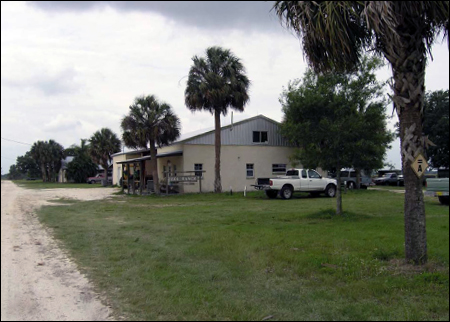
Carlton 2×4 Ranch office building [photo by Jim Selph]
Product Diversification
The ranch has a commercial cow-calf herd of about 1000 head. It markets backgrounded steers to feed-lots or for sale under specialized marketing arrangement including retained ownership to the supermarkets. Heifers are retained and developed for replacement on the ranch and the excess sold as replacements to other needy producers.
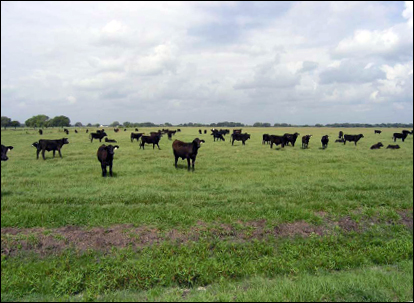
A group of weaned Brangus calves on pasture [photo by Jim Selph]
Citrus groves, which occupy about 875 acres, produce orange juice varieties such as Hamlin, Red Valencia and Valencia for processing.
Supporting income from land management activities accrue from sales of hay, sod, grass seed, timber (500 acres) and native plants. Additional revenue is generated from a variety of leases ranging from hunting & fishing, grazing, watermelon growing, vegetable production and shell pits to dirt mining.
The long standing emphasis of the ranch on superior genetics and feed efficiency for their livestock, quality and efficiency of producing fruits and other products has enabled it to remain one of the top ranch operations in Florida.
Land Resource Management Diversification (Pasture)
Brady and Pat Pfeil manage the properties on 2×4 Ranch with a long-term economic and environmental sustainability as their goal. Over the past 22 years, the Pfeils have learned that maximum production in a cow herd may not mean maximum profit and that "more is not always better". They have found that being a low-input producer means "finding the balance that your resources will support". Towards that goal, where they used to graze an animal unit on 1.6 acres of land with high inputs, today they net as much return with a smaller herd grazing 1 animal unit on 3 acres with short duration rotational grazing, 120 days of protein supplementation, minimal fertilizer application and no hay or energy feed. Tame pastures established on the ranch include Pangola, Slender stem digitgrass, Argentine and Pensacola bahiagrass and Floralta limpograss. These warm season grasses are mixed with legumes such as Aeschynomene, Carpon desmodium, Shaw creeping vigna and white clover to improve their nutritional value. The 3-7 day rotational grazing system uses from 8 to 26 pastures per herd to ensure that cowherd stocking rate is matched to available forage.
Water Resource Management Diversification
The lands of 2×4 Ranch are south Florida flatwoods, slough range sites and fresh water marsh. In this subtropical climate, most of the 56" annual rainfall is received in 3 summer months. Under natural conditions, these areas experience high water tables within 6" of the surface for 3-6 months each year. The sloughs areas actually sheet flow across the surface after minimal rainfalls. Since the soils have a sandy texture at the surface and a hardpan under the surface, they are saturated during the wet season but go through long dry springs yearly. Therefore water management diversification is central to ranch conservation practices. In the 1980's, water control structures were installed in all major drainage canals to allow for the retention of water. With this system, water table is held to the surface for 30 or more days yearly. The practice helps control nematodes and soil-borne insect pests such as mole crickets on pasture and provides higher soil moisture for pasture growth late into the fall and earlier in the spring.
Proper water use in citrus grove is achieved by using tensiometers to schedule irrigation. Irrigation is done only at nights to save large quantities of water. Sub-irrigation (backing water up into the drain tiles to increase soil moisture) aids in freeze protection and lowers water consumption.
Wetlands are maintained and new ones added by a technology-based surface water management system designed by AMS Engineering and Environmental, Inc. Ranch managers have combined the use of wetlands and BMP's in the application of pesticides and fertilizers to their citrus groves so successfully that the Southwest Florida Water Management District has granted mitigation credits to their operation. Additionally, livestock watering ponds support viable marsh habitat in their vicinity due to rest periods between grazing.
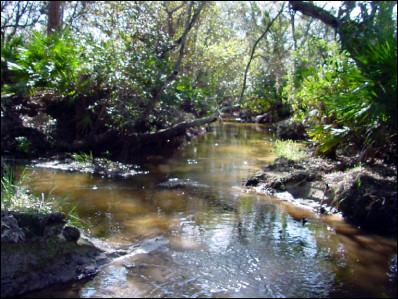
A creek on 2×4 Ranch [photo by Jim Selph]
Natural Resources Diversification
Again in the mid-1980's, the ranch developed a 320 acre slough site to a forest with assistance from the Natural Resources Conservation Service (NRCS). The objective was to encourage wildlife populations. Planting long leaf pines, cypress trees and live oaks were combined with controlled burning, brush chopping and limited grazing periods in the year. Ten miles of fence was built around oak and palmetto roughs, to allow control of cattle grazing and continuous wildlife access. Food plots are planted yearly in the native areas. Legumes introduced for cattle are also available to wildlife. These measures have maximized biodiversity of plant and wildlife species on the ranch. The deer has grown from rare sightings to a stable, well-maintained, large deer herd; Bob white quail and Osceola turkeys have staged a remarkable come back onto the ranch.
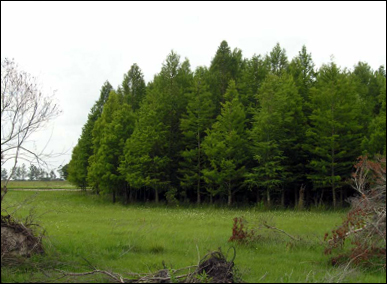
A young cypress plantation developed on 2×4 Ranch [photo by Jim Selph]
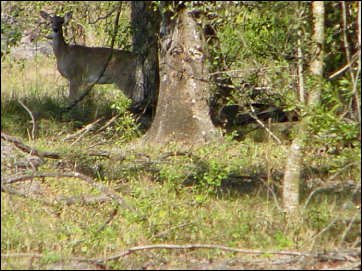
A deer resting in shade under a tree [photo by Jim Selph]
The Carlton Story
The logical question to any visiting inquiring mind becomes "what are the human mind and the history behind this entire great entrepreneurship story?" Historically, the Albert Carlton family moved from north Florida to Hardee County in the mid 1800's and homesteaded in the Peace River Valley area following the Civil War. During the Seminole Indian Wars, Albert's Great Grandfather was killed defending the homestead. Cattle production and citrus groves supported the family as it grew and spread out over central Florida. Albert and Dr. Barbara Carlton continued this family tradition and acquired thousands more acres by the late 1970's. All their properties were handled with the Integrated Resource Management (IRM) process using all known Best Management Practices (BMP) to maintain the environmental and economic sustainability of the land. Today, land stewardship on the 2×4 Ranch is a group effort by this eighth generation Florida Agricultural family led by Dr. Barbara C. Carlton.
Albert and Dr. Barbara Carlton have 4 children – Will Carlton, Pat Carlton, Julie Carlton McClelland and Charlie Carlton. Dr. Barbara Carlton together with the children form an operational partnership of the family (McCarlton Partners Ltd.) to oversee the day to day operations of the ranch and their other investments. Carrying on her husband's tradition of responsible stewardship, Dr. Barbara Carlton sets the standards for operation. Her son, Pat Carlton, actively works with Stewardship America, Peace River Citrus Growers, Florida Citrus Commission, the Florida Cattlemen Association and Nature Conservancy to promote private property rights and to protect the Ranch's management flexibility in this ever-growing regulatory business climate.
The general manager of 2×4 ranch, Stan Pelham, a native Floridian from Bonifay has overseen the financial stability of Carlton Families since 1976. Brady and Pat Pfeil have managed the properties over the past 25 years with long-term economic and environmental sustainability as their goal. Wildlife, citrus groves and cattle flourish on Carlton properties dispelling public perception that you can't have production agriculture and a healthy wildlife population. Much time is spent by Brady and Pat working to correct erroneous public perception while Dr Barbara Carlton hosts several events each year for policy makers providing opportunity to interact and covey their message, that they are the Original Stewards of the Land. For their efforts, Dr. Barbara C. Carlton (Owner) and Patrick Carlton (Managing Partner) of Carlton 2×4 Ranch received the 2001 Commissioner's Ag-Environmental Leadership Award by the Florida Department of Agriculture and Consumer Services, the 2002 Florida Environmental Stewardship Award by Florida Cattlemen's Association and the Region II (eight southeastern States) Environmental Stewardship Award by the National Cattlemen's Beef Association in January 2004.
The ranch has and continues to work with various agencies over the years to provide viable research to support their claims and to encourage the use of as little inputs as possible. Those agencies include the National Resources Conservation Service, Society for Range Management, Florida Cattlemen's Association, Stewardship America, Peace River Citrus Groves, Nature Conservancy and Charlotte Harbor National Estuary Program. We at IFAS are grateful for their cooperation on the Bahiagrass fertilization project conducted by the South Florida Beef/Forage Extension Agents – a 3-year study which resulted in the lowering of the University of Florida/IFAS fertilization recommendations for N, P and K on bahiagrass pastures and look forward to joint future endeavors. For more information on 2×4 Ranch you can visit the web address: 4cpartners.com/McCarlton.htm.

